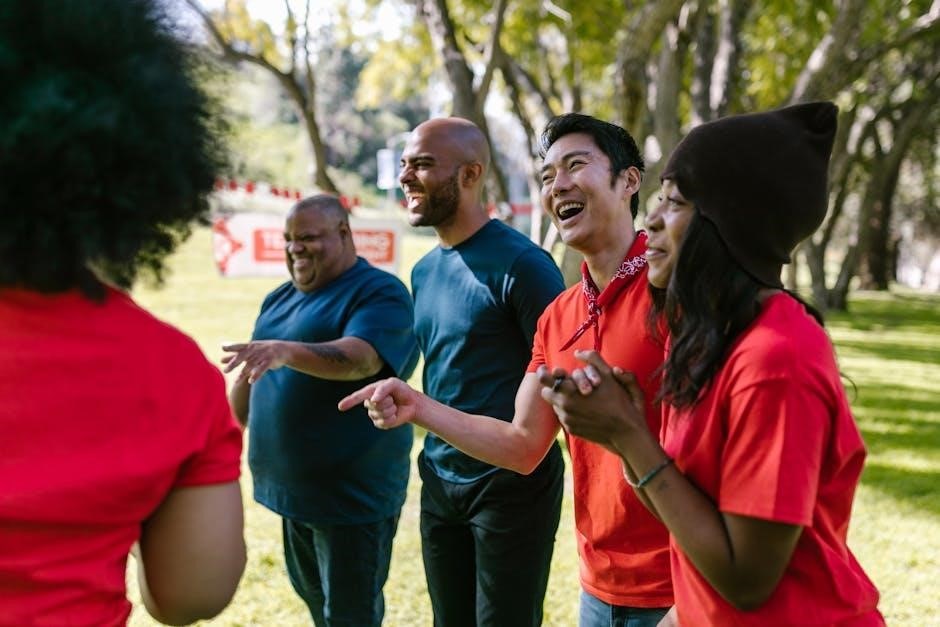group dynamics for teams 6th edition pdf

Written by Daniel Levi and David A. Askay, this 6th edition explores team behavior, blending psychology research with practical insights for workplace collaboration and effectiveness.
Overview of the Book and Its Authors
Group Dynamics for Teams 6th Edition is authored by Daniel Levi and David A. Askay, offering a comprehensive exploration of team behavior and collaboration. Published by SAGE Publications, Inc., the book blends psychological research with practical insights for workplace teams. The authors examine fundamental concepts like goals, norms, cooperation, and communication, while addressing challenges such as conflict and decision-making. Levi, a renowned expert, and Askay provide a balanced approach, making it a valuable resource for understanding and enhancing team dynamics. The Digital and eTextbook ISBNs are 9781544309682 and 1544309686, with print ISBNs 9781544309699 and 1544309694, ensuring accessibility for modern learners.

Key Features of the 6th Edition
The 6th edition of Group Dynamics for Teams offers a refreshed blend of psychological research and practical applications, focusing on workplace team dynamics. It incorporates updated insights on cooperation, communication, and conflict resolution, alongside strategies for fostering creativity and valuing diversity. The book provides real-world examples to illustrate key concepts, making it accessible for both students and professionals. New to this edition is an enhanced emphasis on decision-making and problem-solving processes within teams. Additionally, the authors have expanded discussions on building trust and cohesion, addressing power struggles, and promoting effective leadership roles. These features ensure the book remains a cutting-edge resource for understanding and improving team performance in various organizational settings.
Structure and Organization of the Book
Group Dynamics for Teams 6th Edition is structured to provide a comprehensive understanding of team behavior. The book is divided into clear sections, beginning with foundational concepts such as goals, norms, and communication. It then progresses to team processes like decision-making and conflict resolution. Practical applications, including leadership and building high-performing teams, are also covered. The text is organized into parts, each focusing on specific aspects of group dynamics, ensuring a logical flow from theory to application. This structure makes it easy for readers to navigate and apply the concepts in real-world settings, enhancing both individual and team effectiveness in organizational environments.
Understanding Group Dynamics Concepts
This section introduces foundational concepts like goals, norms, cooperation, and communication, essential for understanding how teams function and interact effectively in organizational settings.

Goals and Norms in Team Dynamics
Goals and norms are fundamental to team dynamics, shaping collective behavior and performance. Goals define the purpose and direction of a team, aligning individual efforts toward shared objectives. Norms are unwritten rules that govern team interactions, influencing communication, cooperation, and decision-making. Understanding these elements is crucial for fostering cohesion and productivity. The 6th edition emphasizes how well-defined goals enhance motivation, while norms ensure consistency and accountability. By addressing these concepts, teams can better navigate challenges and achieve their potential, creating a harmonious and effective work environment. This chapter provides practical insights into establishing and managing goals and norms for optimal team functioning.
Cooperation and Competition Within Teams
Cooperation and competition are dual forces that shape team dynamics, influencing collaboration and productivity. Cooperation fosters a shared sense of purpose, encouraging mutual support and collective problem-solving. In contrast, competition can motivate individuals to excel, driving innovation and performance. However, excessive competition may lead to conflict and undermine teamwork. The 6th edition explores how teams can strike a balance between these dynamics, promoting a collaborative environment while harnessing the benefits of healthy competition. By understanding these forces, teams can optimize their interactions, enhance creativity, and achieve their objectives effectively. This chapter provides insights into managing cooperation and competition to foster a productive and cohesive team culture.
Effective Communication Strategies
Effective communication is a cornerstone of successful team dynamics, fostering collaboration and productivity. The 6th edition emphasizes the importance of clear, concise, and active communication to ensure all team members are aligned and engaged. It explores strategies such as verbal and non-verbal cues, active listening, and feedback mechanisms to enhance understanding and reduce misunderstandings. The book also addresses the challenges of communication barriers, such as cultural differences and technological limitations, providing practical advice for overcoming them. By mastering these strategies, teams can create an open and inclusive environment that promotes shared goals and collective success, ultimately leading to better decision-making and innovation.

Team Processes and Dynamics
Team processes and dynamics involve understanding how teams function, including decision-making, problem-solving, conflict resolution, and fostering creativity and diversity to enhance collaboration and productivity.

Decision Making and Problem Solving
The 6th edition of Group Dynamics for Teams delves into decision-making and problem-solving processes, emphasizing the importance of structured approaches to enhance team effectiveness. It explores methods such as consensus-building, majority voting, and collaborative brainstorming to address complex challenges. The book highlights how diverse perspectives and active participation can lead to innovative solutions while minimizing groupthink. Practical strategies are provided to improve critical thinking, creativity, and adaptability in dynamic work environments. By understanding these processes, teams can make informed decisions and effectively navigate organizational challenges, fostering a culture of continuous improvement and shared responsibility.
Conflict Resolution and Management
The 6th edition of Group Dynamics for Teams provides insights into conflict resolution, emphasizing its role in fostering collaboration and productivity. It identifies common causes of conflict, such as differing opinions, power struggles, and resource competition. Practical strategies, including negotiation, mediation, and constructive communication, are explored to address disputes effectively. The book highlights the importance of emotional intelligence and trust in managing conflicts, ensuring they become opportunities for growth rather than obstacles. By understanding these dynamics, teams can resolve conflicts in a way that strengthens relationships and enhances overall performance, creating a more cohesive and productive work environment.

Creativity and Innovation in Teams
The 6th edition of Group Dynamics for Teams emphasizes the importance of creativity and innovation as essential drivers of team success. It explores strategies to foster a culture of innovation, such as encouraging open communication, diverse perspectives, and risk-taking. The book provides practical techniques, including brainstorming, design thinking, and collaborative problem-solving, to help teams generate creative solutions. By leveraging diversity and promoting a supportive environment, teams can unlock their full potential for innovation. These insights help teams adapt to changing challenges and achieve organizational goals effectively, making creativity a cornerstone of sustainable success in dynamic work environments.
Valuing Diversity and Inclusion

The 6th edition of Group Dynamics for Teams highlights the significance of diversity and inclusion in fostering high-performing teams. It emphasizes how diverse perspectives enhance creativity, problem-solving, and decision-making. The book explores strategies to create an inclusive environment, such as addressing unconscious biases, fostering respect, and promoting equitable participation. By valuing diversity, teams can leverage unique strengths and experiences, leading to better outcomes. The authors provide practical tools to navigate cultural differences and build a culture of inclusion, ensuring all members feel valued and empowered to contribute. This focus on diversity and inclusion is crucial for modern teams aiming to thrive in diverse and globalized workplaces.

Challenges Teams Face
Teams often encounter challenges like conflict, communication breakdowns, and power struggles, which can hinder collaboration and productivity if not managed effectively.
Addressing Conflict and Power Struggles
Conflict and power struggles are common challenges teams face, often arising from differing opinions, competing interests, or unequal distributions of authority. Effective conflict resolution requires fostering open communication, active listening, and a willingness to compromise. Teams must establish clear roles and responsibilities to minimize power imbalances. Leaders should promote transparency and accountability to reduce tensions. Encouraging a collaborative environment where diverse perspectives are valued can help mitigate conflicts. Addressing these issues proactively strengthens team cohesion and enhances overall performance, ensuring that challenges are transformed into opportunities for growth and improved dynamics.
Building Trust and Cohesion
Trust and cohesion are foundational to effective team dynamics, fostering collaboration and shared accountability. Teams thrive when members feel secure and valued, enabling open communication and mutual support. Leaders play a crucial role in modeling trustworthy behavior and encouraging transparency. Consistent actions and fair treatment reinforce trust, while shared goals and collective ownership strengthen cohesion. Regular team-building activities and acknowledging contributions further enhance these dynamics. When trust is nurtured, teams are more resilient, innovative, and capable of overcoming challenges together, ultimately achieving higher levels of performance and satisfaction.

Practical Applications of Group Dynamics
This edition offers practical strategies for leadership, effective communication, decision-making, and conflict resolution, helping teams enhance collaboration and foster innovation in workplace settings.
Leadership Roles in Team Success
Leadership plays a pivotal role in shaping team dynamics, as outlined in the 6th edition. Effective leaders set clear goals, foster collaboration, and promote a positive team culture. They facilitate open communication, resolve conflicts, and empower members to contribute their best. The book emphasizes how leaders can enhance trust and cohesion, essential for high-performing teams. By understanding group dynamics, leaders can adapt their styles to meet team needs, encouraging innovation and accountability. Levi and Askay provide practical strategies for leaders to navigate challenges, ensuring teams achieve their objectives efficiently and effectively. Strong leadership is thus a cornerstone of successful team outcomes;
Strategies for Building High-Performing Teams
Building high-performing teams requires intentional strategies to foster collaboration, trust, and accountability. The 6th edition emphasizes the importance of clear communication, shared goals, and defined roles to align team efforts; Encouraging active participation, recognizing contributions, and promoting a growth mindset are key. Leaders should cultivate psychological safety, enabling team members to voice ideas and take risks. Conflict resolution and continuous feedback mechanisms also enhance team cohesion. By leveraging diversity and inclusion, teams can tap into varied perspectives for innovative solutions; Practical strategies, such as regular team-building activities and adaptive leadership styles, are highlighted to ensure teams thrive in dynamic environments. These approaches collectively drive sustainable team success.